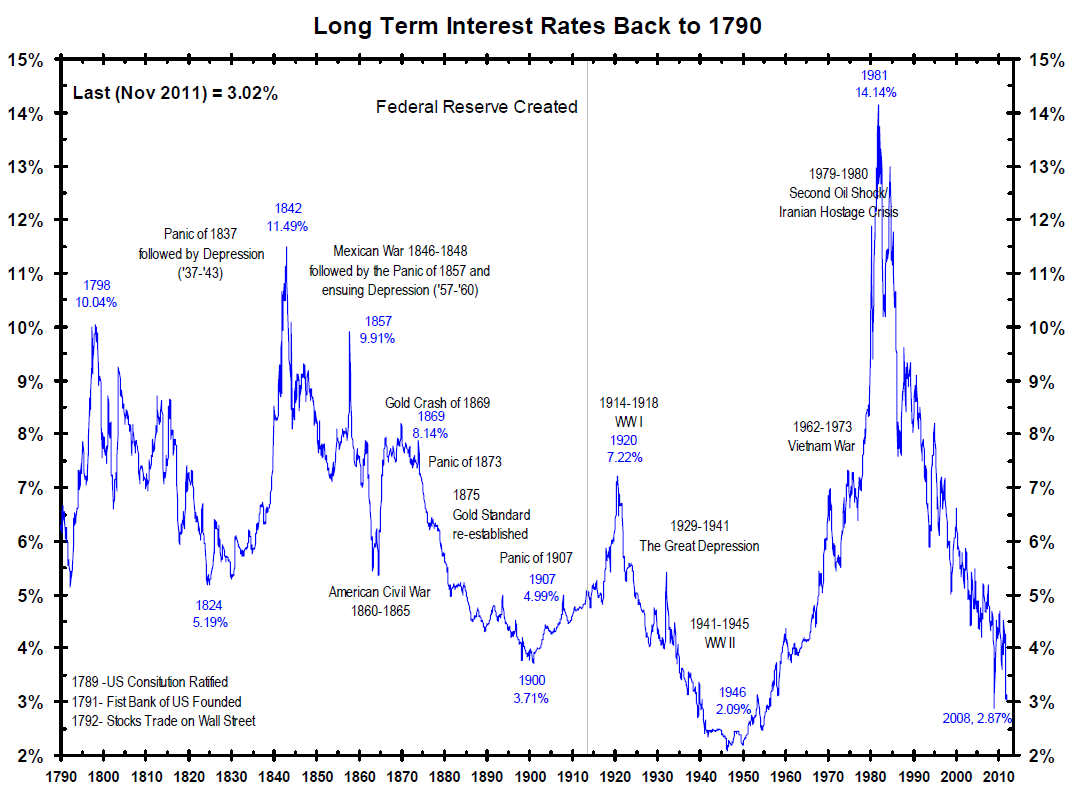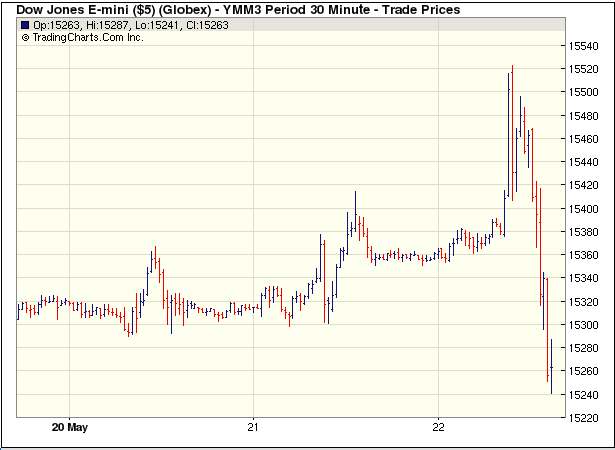Bonds & Interest Rates
1. Gold appears to be entering the “summer doldrums” season, but there are some black swan issues that could add a lot of volatility to the market.
2. Please click here now. You are looking at an article from The Economic Times of India, and it’s pretty clear that demand for gold has slowed down, as it often does at this time of year.
3. When demand for physical gold slows down in India, the price often tends to meander aimlessly, frustrating both the bulls and the bears.
4. Please click here now. That’s the daily T-bond chart. It’s difficult for gold to rise if bonds can’t move higher, and the bond chart seems to suggest that gold is heading for a period of lackluster price action.
5. You can see that my “stokeillator” (14,7,7 Stochastics series) looks terrible.
6. It’s oversold, but it looks tired, like a burnt-out athlete.
7. Please click here now. Double-click to enlarge. That’s the weekly chart of the Dow, and followers of the “sell in May and go away”mantra are extremely frustrated.
8. Many gold market investors are momentum-oriented, and they want to be where the action is, even if there is value in owning gold at the current price.
9. The relentless rise of general equities continues to attract money from gold. That’s unlikely to change unless the Dow “finally” takes a real hit. May has come, and it’s almost gone, and still there is no sizable sell-off!
10. At the end of the 1970s bull market, the Russian invasion of Afghanistan caused investors to pour into the gold market.
11. A geopolitical event like that could be a game-changer for the stagnant condition that gold is experiencing now, but how likely is such an event?
12. Well, the situation in Syria seems to be worsening, and the action of my stokeillator on the daily gold chart does suggest that some sort of rally is imminent.
13. To view that chart, please click here now. There’s a double bottom pattern in play, and the stokeillator lines have just crossed this morning, producing a “buy” signal.
14. I like to buy in anticipation of these crossover signals, focusing my buying around major HSR (horizontal support & resistance).
15. The stokeillator buy signal should come after I’ve bought, so it is really a “potential profits are coming” signal.
16. One geopolitical event that could be a game-changer for the gold price is the civil war in Syria. Syria and Israel both have enormous military forces, and President Assad seems to be having a hard time on the domestic front.
17. It’s unknown who would take Assad’s place if he were to lose the civil war. Regardless of who took over, it’s hard to see the Syria-Israel relationship getting better.
18. Other countries could also take sides in a Syria-Israel war, and many geopolitical analysts are concerned that a large conflict is imminent.
19. Perhaps the Syria-Israel situation explains why my bond market stokeillator is flat lining, while the gold one is hooking up into a crisp buy signal?
20. Please click here now. You are looking at the hourly bars chart for gold. Note how close the gold price is now, to the rising blue trend line.
21. That line represents demand. Aggressive swing traders should be heavy buyers now, with tight stop losses at about $1375. I don’t use stop losses, except in my day trading, which is a small part of my gold market activities.
22. Day trading does help eliminate boredom, but I’ll dare to suggest that a Syria-Israel war will do a much better job at eliminating it. Unfortunately, a war like that is likely to replace boredom with the blood of many innocent people. Governments are the most violent serial killers in the world, in my opinion.
23. Remember that the target of the double bottom on the gold chart is $1680, but it only “activates” if gold trades over $1500. The Syria-Israel conflict could be the geopolitical catalyst that makes it happen. Short covering by funds would reach almost surreal levels, in such a situation.
24. Please click here now. Double-click to enlarge. That’s the weekly GDX chart, and it almost looks like the Dow chart turned upside down. The RSI indicator is particularly oversold. Gold stocks offer value at this point, and they await a black swan event to catapult them higher.
Special Offer For Website Readers: Please send me an Email to freereports4@gracelandupdates.com and I’ll send you my free “Silver Stocks Non Confirmationist’s Dream” report. I’ll show you which key indicators I’ve focused on now, on 5 key silver stocks. These indicators are flashing a very big “non confirmation” with the silver stock prices!
Thanks!
Cheers
St
Note: We are privacy oriented. We accept cheques. And credit cards thru PayPal only on our website. For your protection. We don’t see your credit card information. Only PayPal does. They pay us. Minus their fee. PayPal is a highly reputable company. Owned by Ebay. With about 160 million accounts worldwide.
Written between 4am-7am. 5-6 issues per week. Emailed at aprox 9am daily.
Email: stewart@gracelandupdates.com
Rate Sheet (us funds):
Lifetime: $799
2yr: $269 (over 500 issues)
1yr: $169 (over 250 issues)
6 mths: $99 (over 125 issues)
To pay by cheque, make cheque payable to “Stewart Thomson”
Mail to:
Stewart Thomson / 1276 Lakeview Drive / Oakville, Ontario L6H 2M8 Canada
Stewart Thomson is a retired Merrill Lynch broker. Stewart writes the Graceland Updates daily between 4am-7am. They are sent out around 8am-9am. The newsletter is attractively priced and the format is a unique numbered point form. Giving clarity of each point and saving valuable reading time.
Risks, Disclaimers, Legal
Stewart Thomson is no longer an investment advisor. The information provided by Stewart and Graceland Updates is for general information purposes only. Before taking any action on any investment, it is imperative that you consult with multiple properly licensed, experienced and qualifed investment advisors and get numerous opinions before taking any action. Your minimum risk on any investment in the world is: 100% loss of all your money. You may be taking or preparing to take leveraged positions in investments and not know it, exposing yourself to unlimited risks. This is highly concerning if you are an investor in any derivatives products. There is an approx $700 trillion OTC Derivatives Iceberg with a tiny portion written off officially. The bottom line:
Are You Prepared?

 Ben Bernanke is running “the most inappropriate monetary policy in history” relative to the state of the market warns Stanley Druckenmiller.
Ben Bernanke is running “the most inappropriate monetary policy in history” relative to the state of the market warns Stanley Druckenmiller.

Richard Russell is bullish. While there’s more money sloshing about than he has ever seen in his 88 years of living on this planet and the treasury market has evolved into the biggest bubble in the history of the world, his studies are bullish and the Fed seems to have the Treasury Market well in hand. Despite all this he is still a chronic worrier which is probably a good thing for the rest of us.
Here is one of the latest clips from one of his letters that makes a pretty interesting read:
To be honest, I’m outright bullish on the market myself. Strange, I woke up Sunday morning with this dream. Bear markets are meant to clean out the financial garbage, and put the fear of God into investors and politicians. The crash of 2008-09 failed to do that, mainly because the Fed stepped in and reputedly saved the US and the world from disaster.
Furthermore, bear markets are supposed to put the fear of God into just about everyone. The crash of 2008-09 failed to dampen the speculative ardor of a good many investors. Here we are, about 5 years after the 2008-09 crash, and speculative juices are back again.
Here’s my fantasy — the stock market opens one morning, and there are absolutely no bids. Unexplainably, everyone is frightened at the same time, and everyone decides to wait to see how the market opens. Finally, a few bids come in, and the Dow opens down 400 points. There is a minute of shocked indecision, and suddenly the NYSE is flooded with sell orders.
What happened to the people who had fat paper profits? They were going to sell if the market backed off maybe 50 or 60 points from its record highs. Their strategy didn’t work, not with a market where the Dow opened down 400 points. And that’s where my absurd fantasy ended.
But the reality is that my studies continue to look OK. I’m bullish, although I’m still an incurable worrier. One more thing. The Treasury bond market has evolved into the biggest financial bubble in history. But the Fed has the Treasury market well in hand. So why worry about bonds?
Ed Note: Richard didn’t enclose this Bond Chart, but it is pretty clear where yields were in of 2010 and that they have been improving since then.

Yesterday’s NY Times featured a page 1 story on the incredible luxury-building boom in the City. Evidently, super-luxury housing in NYC is less expensive than it is in London or Hong Kong.
The new 432 Park Avenue super-luxury building will be the tallest residential building in the Western hemisphere. Already the penthouse has been sold for a cool $95 million. Who’s buying these insanely priced apartments? Mostly foreigners who want to establish “getaway” residences, “just in case.”
Other super-luxury buildings are springing up all over NYC. Said one real estate agent, “It’s not location that is so important, it’s all about bigness and pure luxury.” A builder states, “It’s all about helicopter views.” When a person puts $95 million into a New York penthouse, he’s putting his money into an object of tangible value.
But what happens if times get tough? The cost of carrying that penthouse becomes prohibitive. The penthouse is not moveable. Thus paying $95 million for a penthouse is a risky play, and you have to hope that underlying conditions don’t change. Ironically, the same article in the Times states that the median family income in NYC has fallen 8% since 2008.
In the same issue of the Times there appears an ad for two vintage Patek Philippe wrist watches. One is offered for $250,000, the other is priced at $1,200,000.
Russell comment — I’ve never seen so much money being sloshed about. Nor have I ever seen so much news of corruption and criminal activity. Maybe the media is just doing a more thorough reporting job than ever before.
I must admit that I am fascinated with the current stock market. I feel that I am almost daring the market to push higher. And yet, with it all, I don’t see any indications of danger in my studies. If this market does top out, it will top out without any of the usual signs of trouble. Until then, I remain bullish. After all, I’ve never seen a market turn down on its own with no signs of danger prior to the top-out.
“I think the gold miners will fly once gold gets over 1500. This crunch job on gold is the crudest manipulation job I’ve ever seen.
The Fed wants to kill all signs of inflation to hide the damage they’re doing to the middle class. First the Fed leaves food and energy out of the CPI, and then they get the Labor Department to lie about the figures. Their last trick — smash the price of gold and silver. What are they going to do when the bond market (fearful of inflation) collapses? You can’t fool all of the people all of the time.”
To subscribe to Richard Russell’s Daily written Dow Theory Letters CLICK HERE.

 FULL BLOWN JAPAN CRISIS
FULL BLOWN JAPAN CRISIS
Kyle Bass became well-known after successfully predicting and benefitting from the subprime mortgage crisis and his prediction of the European sovereign-debt crisis.
You can pay attention to how this man is positioning himself in this thorough article HERE

Fed Sends Mixed Message
A rally on Wall Street evaporated Wednesday as investors wrestled with mixed messages from the Federal Reserve.
After yesterday’s Broad Blunt Hints from St. Louis Fed President James Bullard and New York Fed President William Dudley. who both essentially said the Fed was going to keep fueling Asset Bubbles by keeping interest rates a breath away from zero by continuing with its present bond-buying program.
Bernanke confirms that stance late this morning PST by stating “A premature tightening of monetary policy could lead interest rates to rise temporarily, but would also carry a substantial risk of slowing or ending the economic recovery and causing inflation to fall further,”
Bernanke also stated that after keeping its key short-term interest rate near zero since December 2008, he expects it to stay there for a “considerable time” as the recovery strengthens, Bernanke said.
The Dow had surged more than 150 points earlier in the day as investors welcomed comments from Fed chairman Ben Bernanke, who told lawmakers that withdrawing monetary stimulus prematurely could derail the economic recovery.
….SUDDENLY
….the momentum faded after the Fed released minutes from its latest policy meeting, which ended May 1.
The minutes said some members of the monetary policy committee were willing to dial down the Fed’s bond-buying program as soon as June if the economic recovery becomes sustainable.

Some good analysis of those minutes by John Hilsenrath:
Federal Reserve minutes from its April 30-May 1 policy meeting suggested it is heading toward some difficult debates on when to pull back its bond buying program.
Below are key passages in the minutes and how to read them:
1) “A number of participants expressed willingness to adjust the flow of purchases downward as early as the June meeting if the economic information received by that time showed evidence of sufficiently strong and sustained growth; however, views differed about what evidence would be necessary and the likelihood of that outcome.”
WHAT IT MEANS: The Fed will debate at its June 18-19 meeting whether to reduce its $85-billion per month bond-buying program, but officials don’t appear near a consensus on the matter. Fed chairman Ben Bernanke suggested in testimony to Congress earlier in the day that he wanted to avoid moving prematurely toward pulling back.
2) “Several participants pointed to the improvement in interest-sensitive sectors, such as consumer durables and housing, over the recent period as evidence that the purchases were having positive results for the economy.”
WHAT IT MEANS: The Fed talks about the costs and benefits of its policies. So far, they think the bond buying program is still helping the economy.
3) “Economic data releases over the intermeeting period were mixed, raising some concern that the recovery might be slowing after a solid start earlier this year, thereby repeating the pattern observed in recent years. Various views on this prospect were offered, from those participants who put more emphasis on the underlying momentum of the economy, noting the strengthening in private domestic final demand, to those who stressed the growing fiscal restraint or the other headwinds still facing the economy.”
WHAT IT MEANS: Fed officials are hesitant about their next step on monetary policy in part because they’re especially uncertain about how the economy unfolds in the next few months, in the face of tighter fiscal policies.
4) “Both headline and core PCE inflation in the first quarter came in below the Committee’s longer-run goal of 2 percent, but these recent lower readings appeared to be due, in part, to temporary factors; other measures of inflation as well as inflation expectations had remained more stable. Accordingly, participants generally continued to expect that inflation would move closer to the 2 percent objective over the medium run.”
WHAT IT MEANS: The Fed’s favored inflation measures have dropped well below its 2% target, but officials aren’t deeply concerned about it yet.












